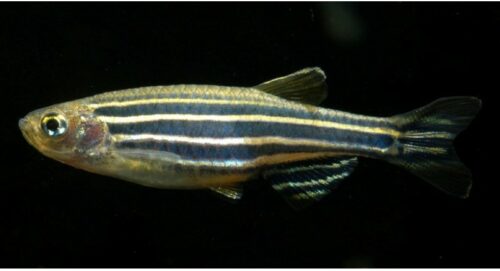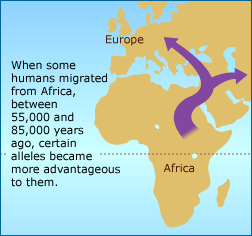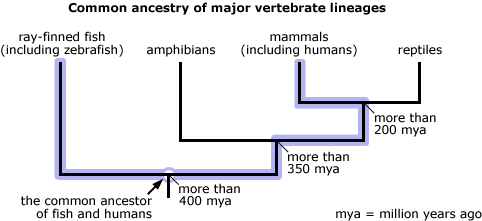
The zebrafish, a small but flashy aquarium pet, may seem like an unlikely informant on questions of human genetics — yet its genome could hold the keys to understanding many diseases and, surprisingly, the genes underlying human skin color. In December 2005, a cancer research team headed by Keith Cheng at Penn State University announced that their studies of the mutant “golden” zebrafish had taken an unexpected turn: they had discovered a single human gene that accounts for about 30% of the difference in skin color between African and European descendants. This color difference can be traced back to a tiny difference in two versions (or alleles) of the gene. The “G” allele is common among African descendants and causes more of the dark pigment melanin to be present in skin cells, while the “A” allele is common among European descendants and causes less melanin in skin cells.
Where's the evolution?
But how did scientists get from a “golden” fish to human ethnic groups, and what does this all have to do with evolution? The answer relies upon the evolutionary relationship between humans and fish and helps illuminate how and why human skin color differences evolved in the first place.

Though the Human Genome Project has revealed the string of three billion base pairs that represents our genetic sequence, we still know relatively little about the meaning of that sequence. However, because all life on Earth shares common ancestors and because we and other species have inherited many of the same genes from those ancestors, we can learn more about our own genome by studying the genes of other species. For example, researchers can experimentally manipulate a gene in another organism (such as a zebrafish) in order to figure out how the gene works and then look for the homologous gene in humans — the version of the gene that humans also inherited from an ancestor we share with the study organism.
That strategy was the approach that the Penn State researchers took when they began studying the zebrafish. The common ancestor of humans and zebrafish swam in the oceans more than 400 million years ago. Despite the enormous length of time that separates those two lineages, they share many genes, such as this recently-discovered pigmentation gene. The zebrafish and human versions of the gene are about 70% identical. In zebrafish, the gene codes for dark stripes — but by breaking the gene and cutting short the protein that it produces, researchers can engineer a golden-hued zebrafish without dark stripes. The same gene was also discovered in the human genome, where it explains much of the difference in skin color between African and European descendants. Interestingly, the gene variants that correspond to dark and light skin in humans are remarkably similar to one another — they differ by just one base pair!
But how did different ethnic groups wind up with these different versions of the pigmentation gene? Research suggests that more than 100,000 years ago, the earliest humans lived in Africa and carried the “G” allele, which causes lots of melanin to be present in skin cells and hence, dark skin. Melanin absorbs UV rays from the sun and controls the amount of UV radiation that penetrates our skin. Our bodies need some UV radiation (to build the essential vitamin, vitamin D) but not too much (because UV radiation can damage the skin and destroy another essential vitamin, folate). In the sun-drenched environs of Africa, dark skin was advantageous, preventing UV rays from doing too much damage, while allowing in enough UV to synthesize vitamin D. In that environment, individuals born with a mutant version of the gene associated with less melanin and lighter skin would probably have had poor health and low reproductive success.
 Many biologists hypothesize that between 55,000 and 85,000 years ago, humans began to migrate out of Africa. Some of them wound up living in the colder, darker climes of Europe. There, too much UV radiation was not a problem, but too little UV to synthesize vitamin D probably was. At some point either before or after the migration out of Africa, a mutation occurred in one of the ancestors of modern Europeans. This mutation was tiny, changing just a single base, but it caused much less melanin to be present in the skin of those who carried the mutation. This was the “A” allele. Among the new Europeans, this allele likely had an advantage over the “G” allele. Individuals carrying the “A” allele had less melanin, which allowed more UV light to penetrate their skin, which could have allowed them to synthesize vitamin D better than those carrying only the “G” allele. These “A”-carrying individuals had increased reproductive success in their sun-poor environment, and via natural selection, the “A” allele spread throughout the European population. Meanwhile, among Africans, the “G” allele continued to be advantageous and to maintain its majority there.
Many biologists hypothesize that between 55,000 and 85,000 years ago, humans began to migrate out of Africa. Some of them wound up living in the colder, darker climes of Europe. There, too much UV radiation was not a problem, but too little UV to synthesize vitamin D probably was. At some point either before or after the migration out of Africa, a mutation occurred in one of the ancestors of modern Europeans. This mutation was tiny, changing just a single base, but it caused much less melanin to be present in the skin of those who carried the mutation. This was the “A” allele. Among the new Europeans, this allele likely had an advantage over the “G” allele. Individuals carrying the “A” allele had less melanin, which allowed more UV light to penetrate their skin, which could have allowed them to synthesize vitamin D better than those carrying only the “G” allele. These “A”-carrying individuals had increased reproductive success in their sun-poor environment, and via natural selection, the “A” allele spread throughout the European population. Meanwhile, among Africans, the “G” allele continued to be advantageous and to maintain its majority there.
The discovery of this pigmentation gene has helped us piece together a more complete picture of the evolutionary changes that underlie skin color differences between human ethnic groups. It suggests that a great deal of the skin color difference that has delineated the boundaries of social tensions for much of recorded history can be traced back to a tiny genetic change that allowed humans to better survive and reproduce in particular environments.
This discovery also highlights the fundamental similarity of all humans. Skin color, it turns out, really is skin deep; at a genetic level, the skin color difference between a European descendant and an African descendant might be largely influenced by a single base pair difference in a genome composed of three billion base pairs. However, neither does this single gene tell the whole story. For example, many East Asians carry the “G” allele and yet have light-colored skin. Why? We don’t know, but it is probably due to many other undiscovered genes. And though, on average, people who carry only the “A” allele have lighter skin than those who carry only the “G” allele, there is a huge overlap in skin color between the groups — so knowing which alleles an individual carries will not let you predict with much certainty the shade of his or her skin. It is clear that the concept of “race” is more a sociological construct than a biological one, and that many genes and environmental factors influence skin color. As we learn more about these genes, we will learn more about our own evolutionary history as a species.

Finally, methods used to discover this pigmentation gene reveal the deep connections between our own species and others that have lived over the approximately 3.5 billion years of life’s history. Studying the zebrafish, for example, led to discoveries about our own evolutionary history and genetic variation. And because of the common ancestry of all life on Earth, other species (as different from us as they may seem) represent our evolutionary cousins and can teach us about ourselves and our history.
News update, August 2013
This new story from 2006 describes a gene that affects skin coloration in humans and that accounts for about 30% of the difference in skin color between African and European descendants — but what about the other 70%? Well, scientists have been working on that and have identified many additional genes that influence skin pigmentation. Recently, a team of biologists from the Netherlands tackled this problem with a new approach. Prior studies had treated human skin color as a discrete trait, with people falling into discrete categories (e.g., black/olive/fair). However, just from looking around any college campus, it should be clear that skin color is a continuous trait that can vary nearly imperceptibly among individuals — even ones of the same ethnic background. To account for this, the Dutch biologists relied on photos of more than 5000 light-skinned individuals, which were scanned by a computer system to assess a continuous range of color values. The researchers then looked for correlations between different gene versions and tendencies towards different skin color dimensions. Using this method, the scientists were able to identify two new genes that seem to influence skin hue and saturation. This approach (treating skin color as the continuous trait that it is) can be applied to other groups with broadly similar skin colors and is likely key to discovering many additional genes of small effect. It isn’t yet known whether such subtle variations have been shaped by natural selection over our evolutionary past — but stay tuned to keep up to date with new research as it comes out!
Primary literature:
- Jablonski, N. G., and Chaplin, G. (2000). The evolution of human skin coloration. Journal of Human Evolution 39(1):57-106. Read it »
- Lamason, R. L., Mohideen, M. P. K., Mest, J. R., Wong, A. C., Norton, H. L., Aros, M. C., et al. (2005). SLC24A5, a putative cation exchanger, affects pigmentation in zebrafish and humans. Science 310(5755):1782-1786. Read it »
News articles:
- A quick overview from Scientific American
- A review of the science behind the discovery from Science and MSNBC
- An in-depth article focusing on implications for conceptions of race from the Washington Post
- A summary of some of the technical details of the discovery from Penn State University
Understanding Evolution resources:
- How is the zebrafish pigmentation gene relevant to the human pigmentation gene discussed here?
- What is a homology? Describe an example of a homology from the article above. Describe an example of a homology NOT mentioned in the article above.
- List some ways in which melanin could be helpful for human survival and reproduction. List some ways in which melanin could be bad for human survival and reproduction.
- In what circumstances is the “A” allele advantageous for humans? In what circumstances is the “G” allele advantageous for humans? Is one better than the other? Explain why or why not.
- Review some background information on natural selection. Imagine that in the ancestral European population, the “G” allele is common and just a few people carry the mutant “A” version of the gene. Explain how the allele frequencies of “A” and “G” would have changed over many generations in the sun-poor environment of Europe. Make sure to include the concepts of variation, selection, and inheritance in your explanation.
- Teach about homologies and analogies: This interactive investigation for grades 9-12 explains what homologies and analogies are, how to recognize them, and how they evolve.
- Teach about natural selection: In this lesson for grades 9-12, students demonstrate the process of natural selection using a dish of mixed candies to represent alternate alleles or phenotypes.
- Teach about different hypotheses regarding early human evolution and migration patterns: In this article for AP biology students or undergraduates, paleoanthropologist Donald Johanson describes how and when early humans evolved, Homo sapiens' ancestors and relatives, and the diverse lines of evidence relating to this history.
- Biello, D. (2005, December 16). Researchers identify human skin color gene. Scientific American. Retrieved January 17, 2006 from Scientific American
- Jablonski, N. G., and Chaplin, G. (2000). The evolution of human skin coloration. Journal of Human Evolution 39(1):57-106.
- Lamason, R. L., Mohideen, M. P. K., Mest, J. R., Wong, A. C., Norton, H. L., Aros, M. C., et al. (2005). SLC24A5, a putative cation exchanger, affects pigmentation in zebrafish and humans. Science 310(5755):1782-1786.

